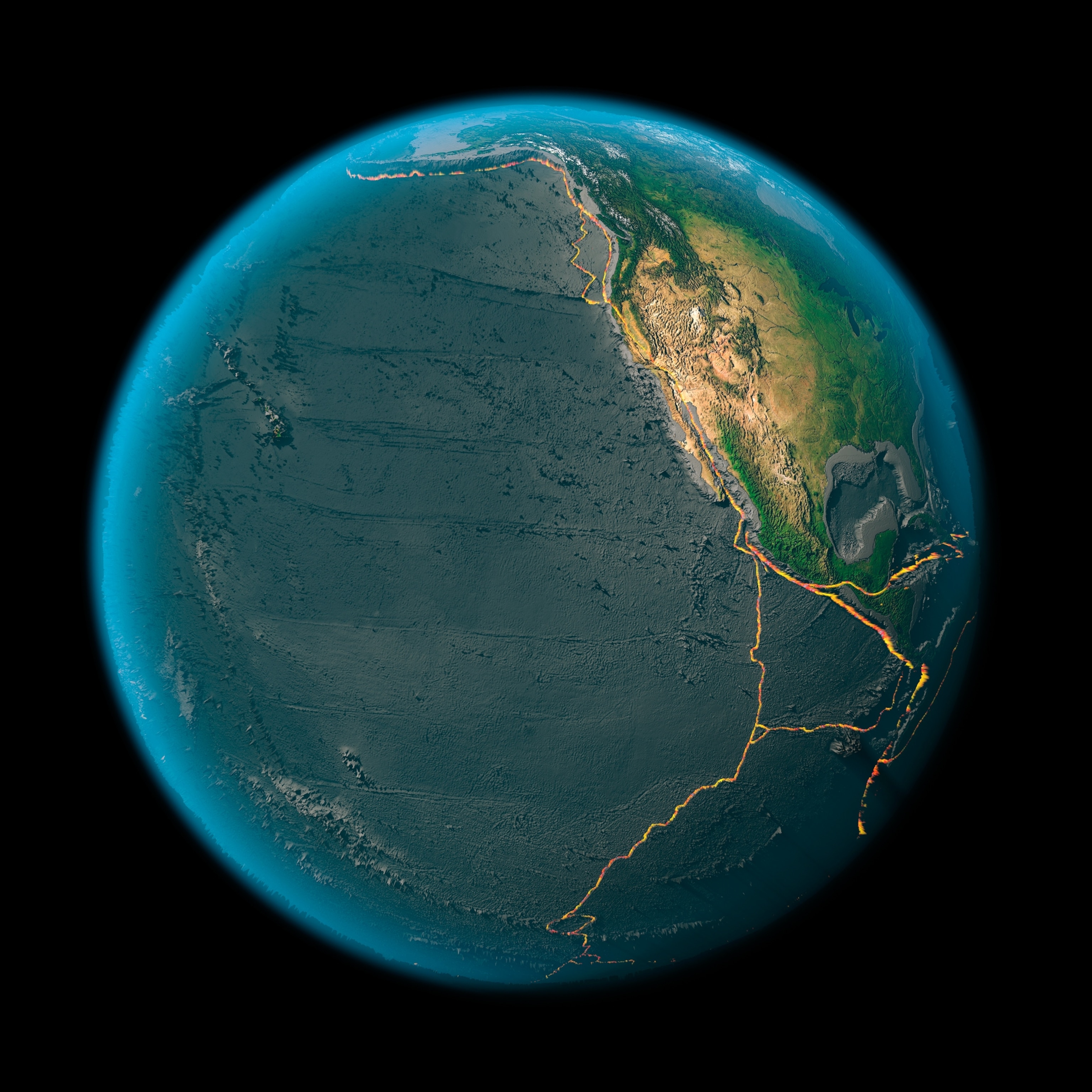Beneath the cerulean waters of Monterey Bay, just a few miles southeast of Santa Cruz, California, a never-before-seen cluster of faults has been found lurking on the ocean floor.
These newly spotted wrinkles in Earth’s crust, described in a paper published today in Science, are still largely a mystery. We can’t say much about their size, shape, or how active they are. Still, the findings show that even in one of the most seismically studied corners of the planet, fault maps of the ocean floor contain gaping holes. That’s a big problem, because if we don’t know where seafloor faults are, coastal communities are going to be in the dark about any earthquake or tsunami threats they might present.
The new research also offers a solution to our tectonic blindspot: We can harness the hundreds of thousands of miles of fiber optic cables that send emails, Tweets, and video messages ping-ponging across Earth every day. Scientists discovered California’s newest known offshore faults by borrowing a garden hose-size fiber optic cable that spans the seafloor of Monterey Bay and turning it into an ad-hoc seismic array. (Also find out how researchers used ancient Aztec records to find a previously unknown seismic risk in Mexico.)
Researchers hope this new method might one day be used to collect treasure troves of seismic data in major cities that are already undergirded by networks of fiber optic telecommunications cables but don’t have the budget or physical space to install thousands of seismometers. Cables located directly offshore of major population centers, meanwhile, might be slightly retooled to serve as the backbone for new early warning systems.
“The possibilities are pretty large,” says study coauthor Craig Dawe of the Monterey Bay Aquarium Research Institute. “Worldwide, there’s lots of fiber optic cable deployed.”
Illuminating the seafloor
Across the western U.S., a dense network of seismic stations provides geologists with a steady stream of information about motion in Earth’s crust, allowing them to monitor famously active fault zones and spot new tremors at a moment’s notice. But once you set sail into Pacific waters, the number of seismic listening stations drops off dramatically. Our fault maps also become patchier, meaning that often we’re not only deaf to undersea earthquakes, we aren’t totally sure where to look for them.
“On shore, we have this idea that we understand everything about Earth’s crust,” says lead study author Nate Lindsey, a Ph.D. candidate at the University of California, Berkeley. “But off shore, it’s like streetlights—when you shine a streetlight on the seafloor, you see something. We just don’t have very much illumination.” (Even on land, we’re still learning about fault systems, like this recently reassessed fault under Los Angeles that was presumed dormant.)
Lindsey and his colleagues are now trying to brighten up the deep with an emerging technique called distributed acoustic sensing. The method involves shooting pulses of laser light through a fiber optic cable until it encounters very tiny density variations in the glass wires that cause the light to bounce back toward its source. Those variations are influenced by motion in the ground, meaning seismologists can use the backscattering patterns to spot earthquakes or even discover new fault structures.
“We can have information like a seismometer would give us if there was a seismometer every two meters,” says Philippe Jousset, a geophysicist at the GFZ German Research Centre for Geosciences who wasn’t involved with the paper. “We can increase the spatial resolution by a factor of a hundred, maybe more.”
Lindsey and his colleagues spent about eight months validating the technique by collecting measurements using a land-based cable run by the U.S. Department of Energy near Sacramento. Then, in March 2018, an opportunity to test the method off shore presented itself when the Monterey Accelerated Research System, or MARS, science cable went offline for scheduled maintenance.
Normally, this 32-mile-long bundle of fiber optic wires carries power to a permanent deep-sea observatory. But for four days, Lindsey and his colleagues shot laser light through the otherwise powered-down cable and collected seismic data. The light traveled for up to about 12 miles, effectively creating a network of 10,000 undersea seismometers.
During the experiment, a magnitude 3.4 earthquake struck on shore near Gilroy, California. Seismic waves from the event rippled across the seafloor, scattering some of their energy as they moved through fault zones and lighting up the previously unseen offshore cluster.
Seismic “game-changer”
Now that the team has shown the method works off shore, they are keen to see it applied to other ocean environments, particularly coastal regions that face known seismic threats.
This sort of seismic listening currently has a limited range of a few dozen miles maximum in terms of lateral distance. But that could light up a wealth of poorly studied offshore environments, like the Pacific Northwest’s Cascadia subduction zone, to detailed seismic monitoring. (Find out about a tectonic plate that’s “dying” under Oregon and what that means for the Cascadia zone.)
The undersea fibers already present off Oregon and Washington State “might be put into service to provide data for tsunami and earthquake monitoring and early warning and for basic scientific studies of an obscure realm,” Paul Bodin, the network manager of the Pacific Northwest Seismic Network, says in an email. The new study, he adds, provides a "4-day-long 'peek through the keyhole' of what we will one day be doing 24/7."
And while finding new faults along this part of California’s continental shelf isn’t too surprising, given that it’s a very seismically active area, further research will help scientists assess the structure of these tectonic etchings and determine whether they pose any hazards.
Lindsey’s team is eventually hoping to co-opt the MARS cable for about a year to collect additional data on the seismic environment. Dawe notes that the recent experiment was only able to illuminate a portion of the seafloor the MARS cable traverses, but with further technological refinement, scientists might be able to light up its entire length—and that could lead to more unexpected discoveries.
“If we could monitor the whole length, we would be able to map faults all the way out,” he says. “Then, it’s a game-changer.”









